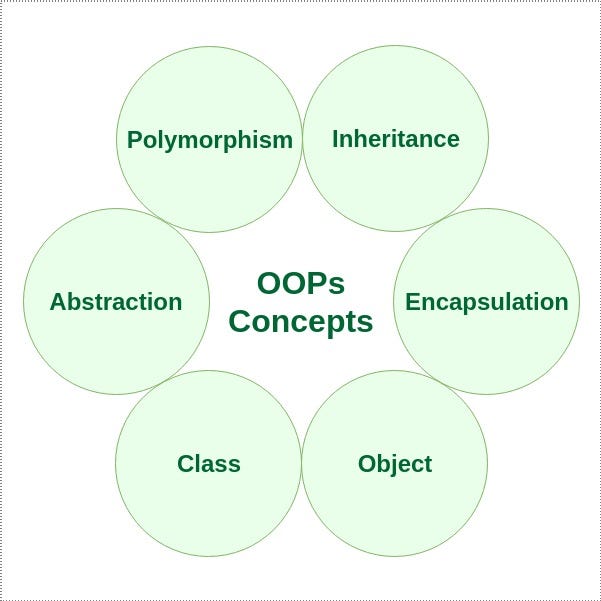🚀 OOPs Unlocked: Master All Key Principles with Real-World Examples & Their AI/ML Magic! 🧠💡
🚀 OOPs Unlocked: Master All Key Principles with Real-World Examples & Their AI/ML Magic! 🧠💡
Object-Oriented Programming (OOP) is the backbone of modern software development, enabling reusable, scalable, and maintainable code. But did you know OOP principles are also critical in AI and Machine Learning (ML)?

In this guide, we’ll break down all core OOP concepts with real-world examples, their AI/ML relevance, and best usage scenarios — so you can apply them like a pro!
🔹 1. Class & Object: The Building Blocks
What are they?
- A class is a blueprint (e.g.,
Car). - An object is an instance of a class (e.g.,
myTesla = Car()).
Example:
📱 Smartphone Class
- Attributes:
model,battery_life - Methods:
make_call(),charge()
AI/ML Relevance:
- Scikit-learn models (e.g.,
model = RandomForestClassifier()). - Neural networks (each layer is an object).
Best Usage:
✅ When modeling real-world entities (e.g., users, devices).
✅ Creating reusable ML components (e.g., custom layers in TensorFlow).
🔹 2. Encapsulation: Hide the Complexity!
What is it?
Bundling data (attributes) and methods (functions) into a single unit (class) while restricting access.
Example:
🏧 ATM Machine
- You insert a card and withdraw cash (
withdraw()), but internal validation is hidden.
AI/ML Relevance:
- TensorFlow/Keras hides backpropagation details.
- Model wrappers protect sensitive training data.
Best Usage:
✅ Secure systems (e.g., banking, healthcare AI).
✅ Clean API design (hide complex ML logic).
🔹 3. Inheritance: Reuse & Extend!
What is it?
A child class inherits properties and methods from a parent class.
Example:
🛒 E-commerce Products
- Parent:
Product(hasname,price). - Child:
Book(addsauthor),Electronics(addswarranty).
AI/ML Relevance:
- Transfer Learning (fine-tuning
BERTfor NLP tasks). - Custom scikit-learn estimators (extending
BaseEstimator).
Best Usage:
✅ Avoiding code duplication.
✅ Adapting pre-trained AI models.
🔹 4. Polymorphism: One Interface, Multiple Forms!
What is it?
Same method behaves differently based on the object.
Example:
🎵 Media Player
play()works forAudio,Video, andPodcastobjects.
AI/ML Relevance:
- Same
fit()andpredict()across SVM, RandomForest, Neural Networks. - Generative AI (same
generate()for text, images, music).
Best Usage:
✅ Flexible ML pipelines.
✅ Plugin-based AI systems.
🔹 5. Abstraction: Simplify Complexity!
What is it?
Hiding complex details and exposing only essential features.
Example:
🚗 Self-Driving Car
- You press “Drive,” but don’t handle sensor fusion or pathfinding.
AI/ML Relevance:
- AutoML tools (e.g., Google AutoML, H2O.ai).
- High-level APIs (e.g.,
keras.Model.fit()).
Best Usage:
✅ Simplifying AI for end-users.
✅ Building ML frameworks.
🔹 6. Association: Objects Working Together
What is it?
Objects interact without tight coupling.
Example:
👨🏫 University System
StudentandCourseare separate but linked.
AI/ML Relevance:
- Modular ML pipelines (e.g.,
DataLoader↔Model). - Microservices in AI deployment.
Best Usage:
✅ Loose-coupled systems.
✅ ML workflow orchestration.
🔹 7. Composition: Building Complex Objects
What is it?
A class contains objects of other classes.
Example:
💻 Computer
- Composed of
CPU,RAM,Storage.
AI/ML Relevance:
- Ensemble models (e.g., RandomForest = many DecisionTrees).
- Neural network architectures (layers as components).
Best Usage:
✅ Complex system design.
✅ Custom AI model architectures.
🔹 8. Aggregation: A Special “Has-A” Relationship
What is it?
A weaker form of composition (objects can exist independently).
Example:
🛒 Shopping Cart & Products
- Cart “has” products, but products exist without a cart.
AI/ML Relevance:
- Feature stores (reusable across ML models).
- Model registries (tracking trained models).
Best Usage:
✅ Shared resources in ML systems.
🔥 OOP in AI/ML Cheat Sheet

🎯 Why OOP Matters in AI/ML?
✔ Cleaner code → Easier debugging.
✔ Reusability → Faster experimentation.
✔ Scalability → Handle complex AI systems.
✔ Maintainability → Team collaboration.
Start leveraging these principles to build robust AI/ML systems today! 🚀
💬 Which OOP concept do you find most useful in AI/ML? Drop a comment! 👇
#AI #MachineLearning #OOP #Programming #DataScience #TechTips #SoftwareEngineering
Comments
Post a Comment